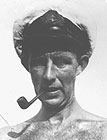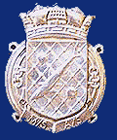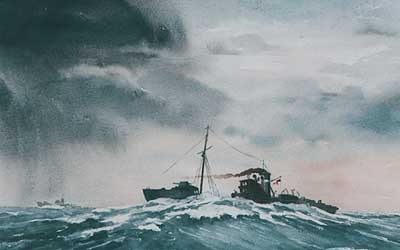


 |
 |
 |
 |
(left)
HMT Leicester City 1940 (painting
courtesy of of B.L. Moir) |
|
My parents had taken me three times to see the play by Sherif of World War One entitled "Journeys End". The conditions in the trenches, and the sufferings, installed in me a terrible fear of war - particularly of war on land. I had always been a lover of the sea and thus I became determined to fight any war, that should materialise, as a seaman. That is the background that made me join the Little Ship Club in London. Here they ran various courses in seamanship, leading up to the Board of Trade's Yachts Masters Ticket, which I took. In the Summer of 1939, The Port of London Authority called for volunteers and small craft, to patrol the Thames, basically as minewatchers as, by then, it looked like a war was, becoming inevitable. This I immediately joined and by August 1939 found myself as a deckhand on a converted R.N.L.I. boat called "Wandered". Joining at the same time with his famous barge "Water Gypsy" was the well known author, A.P. Herbert. We were based on the Training Ship H.M.S. Stork at Hammersmith. Our duties were to patrol the Thames from Hammersmith to Gravesend and report any mines that might be dropped. I was on board H.M.S. Stork when I heard Chamberlain's message on the air saying that we were at WAR with Germany on September 3rd 1939. That evening, whilst patrolling off Green Hythe, for the second time that day, the Air Raid Sirens went off and complete darkness surrounded us. It would be about 10pm. Five minutes before this Air Raid Warning, the skipper of our boat ordered us to top up the fuel tanks (petrol) from the reserve tank in the stern. It all happened so suddenly and the skipper made an immediate decision to throw the anchor over and "Abandon Ship" This we readily did! Next
morning, at low tide, all that could be seen was an anchor chain and
a chard hull on the mud bank. That was my first experience of "WAR
AT SEA". |
|
With
The Wavy Navy The
first week in January 1940 found me at King Alfred's Training School
for Officers based at Hove. There was a great shortage of uniforms and I departed in a civilian suit but a naval cap - hence the famous signal from C in C Med to the Ministry of Supply, London which reads "Wrens clothing to be held up until such time as the needs of seagoing personnel are satisfied". My particular group of new officers were allocated to "SMALL SHIPS" i.e. Coastal Forces and the Royal Naval Patrol Service. Due to shortage of coastal escort forces and minesweepers, the Admiralty had requisitioned many of the deep sea trawlers for these purposes. It was to one of these trawlers, H.M.T. Leicester City that I was drafted. She was being converted to an anti-submarine escort ship in Birkenhead Docks. |
 |
 |